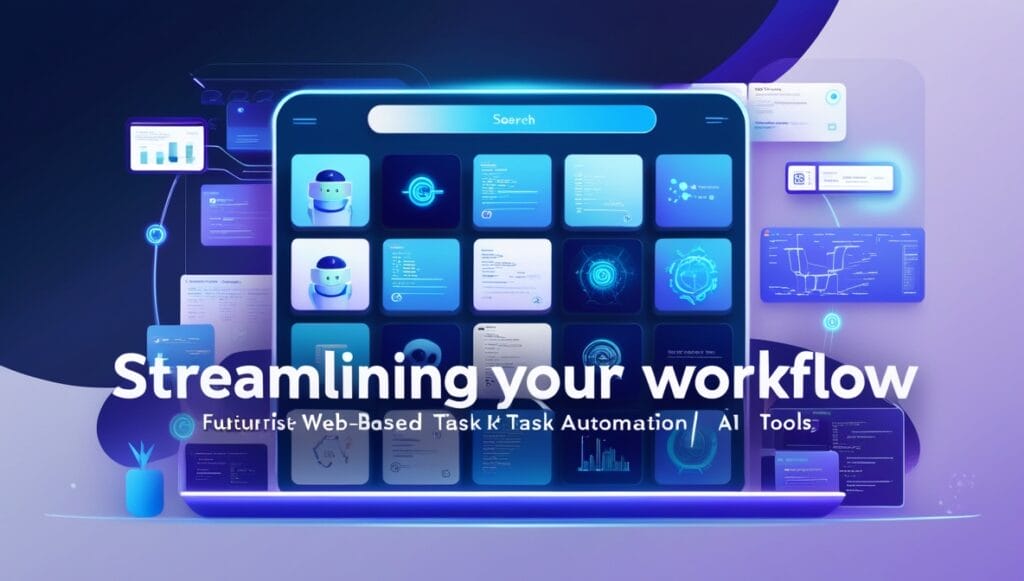10 Business AI tools by abc-media.net
Description

Introduction
In today’s fast-paced business environment, staying ahead of the curve requires leveraging innovative technologies that enhance productivity, streamline operations, and improve decision-making processes. AI has fundamentally altered the landscape of many industries, impacting how organizations operate, make decisions, and interact with customers. Businesses are increasingly adopting AI-powered tools to gain insights, automate tasks, and optimize their strategies.
The article “10 Business AI Tools by abc-media.net“ delves into some of the most impactful AI solutions available today. These tools are designed to address diverse business needs, ranging from automating repetitive tasks and improving customer engagement to data analysis and strategic planning. By incorporating these AI-driven tools, businesses can unlock new efficiencies, enhance customer experiences, and make data-backed decisions with greater accuracy.
This exploration of AI tools by abc-media.net is an essential guide for business leaders and professionals seeking to harness the power of AI. It offers valuable insights into how these technologies can be integrated into everyday operations to achieve sustainable growth and maintain a competitive edge in the digital era.
1. Predictive Analysis AI Tools

Predictive analysis AI tools are among the most powerful innovations transforming how businesses make informed decisions. As highlighted in “10 Business AI Tools by abc-media.net,” these tools harness the potential of AI to analyze historical data and forecast future trends with remarkable accuracy.
Functionality:
These tools, such as IBM Watson Studio and Microsoft Azure Machine Learning, are designed to process vast datasets, identify patterns, and generate predictive insights. They use advanced machine learning algorithms to model scenarios, enabling businesses to anticipate outcomes and proactively address challenges. Predictive analysis tools integrate seamlessly with existing business systems, offering real-time data processing and actionable insights.
Benefits:
Predictive analysis AI tools empower businesses to understand customer behavior, market dynamics, and operational trends. This capability is invaluable for strategic planning, as it allows organizations to make data-driven decisions, reduce risks, and optimize resources. For example, businesses can forecast customer demand, identify sales opportunities, or mitigate potential losses by analyzing patterns in past transactions or market activities. The insights provided by these tools enhance agility and foster innovation, ensuring that businesses remain competitive in a fast-evolving landscape.
By leveraging predictive analysis AI tools, companies gain a significant advantage, enabling them to transition from reactive to proactive strategies, a key aspect of success in today’s data-driven world.
2. Chatbots for Customer Experience

In the digital age, exceptional customer service is a cornerstone of business success, and AI-driven chatbots have emerged as indispensable tools in achieving this goal. As explored in “10 Business AI Tools by abc-media.net,” these intelligent systems are transforming customer interaction by delivering instant, personalized assistance around the clock.
Functionality:
AI chatbots are designed to engage with customers in natural, human-like conversations through websites, apps, or messaging platforms. They use natural language processing (NLP) to understand and respond to queries, making interactions seamless and intuitive. Advanced chatbots are capable of handling multiple languages, integrating with CRM systems, and learning from past interactions to improve over time. Leading platforms, such as ChatGPT, Zendesk AI, and Drift, have set new benchmarks for customer engagement by automating responses to frequently asked questions and providing step-by-step assistance for complex processes like troubleshooting or order tracking.
Benefits:
The use of AI-driven chatbots significantly enhances customer satisfaction by reducing response times and ensuring consistent support across all channels. Unlike human representatives, chatbots are available 24/7, enabling businesses to address customer needs instantly, regardless of time zones or operating hours. Chatbots empower human agents to elevate customer service by automating repetitive tasks, enabling them to deliver exceptional solutions to challenging issues.
Moreover, chatbots gather valuable customer data during interactions, offering insights that businesses can use to improve services, personalize offerings, and anticipate future needs. In industries such as e-commerce, banking, and healthcare, these tools have proven instrumental in reducing operational costs while elevating the overall customer experience.
By incorporating AI-driven chatbots, businesses can not only meet the growing expectations of today’s customers but also gain a competitive edge in delivering high-quality, scalable, and cost-effective support solutions.
3. Sales AI Tools

Sales are the lifeblood of any business, and leveraging technology to optimize sales processes can lead to significant growth and efficiency. As highlighted in “10 Business AI Tools by abc-media.net,” AI-powered sales tools are transforming how organizations analyze sales data, identify opportunities, and enhance overall sales performance.
Functionality:
Sales AI tools, such as Salesforce Einstein and HubSpot Sales Hub, are designed to analyze vast amounts of sales data to uncover patterns and trends. These tools use machine learning algorithms to provide actionable insights, such as identifying high-potential leads, predicting customer purchasing behavior, and recommending personalized sales strategies. Advanced sales AI platforms integrate with CRM systems and marketing software, creating a unified ecosystem that ensures sales teams have access to real-time data and insights.
Sales AI tools also offer features like automated lead scoring, opportunity prioritization, and predictive forecasting. These functionalities help sales representatives focus on the most promising leads and tailor their pitches to meet individual customer needs, increasing the chances of closing deals.
Benefits:
The primary benefit of sales AI tools is the ability to make data-driven decisions that enhance sales efficiency and effectiveness. By providing a deeper understanding of customer behavior and market trends, these tools enable businesses to refine their sales strategies, allocate resources more effectively, and maximize revenue.
For example, predictive analytics in sales tools can forecast demand, helping businesses anticipate stock requirements or adjust marketing campaigns accordingly. Automated workflows reduce administrative burdens on sales teams, allowing them to concentrate on building relationships and driving conversions.
Furthermore, sales AI tools contribute to long-term growth by identifying cross-selling and upselling opportunities, ensuring a steady increase in customer lifetime value. As businesses continue to embrace AI, these tools will remain essential for maintaining a competitive edge and delivering personalized, impactful sales experiences.
4. Lead Management AI Tools

Managing leads effectively is critical for converting potential customers into loyal clients. AI-powered lead management tools have emerged as a game-changer in this domain, automating processes and ensuring a personalized approach to lead nurturing. As discussed in “10 Business AI Tools by abc-media.net,” tools like Podium are transforming how businesses interact with their prospects, making the process more efficient and human-like.
Functionality:
Lead management AI tools are designed to capture, organize, and manage leads from various channels, including websites, social media, and email campaigns. These tools use AI algorithms to prioritize leads based on their likelihood to convert, ensuring sales teams focus their efforts where they are most likely to see results.
Podium, for instance, offers features like automated communication scheduling, lead tracking, and real-time notifications. The tool enables businesses to engage with leads promptly through channels such as SMS, email, or chat, ensuring no opportunity slips through the cracks. Additionally, these tools analyze lead behavior to tailor communication strategies, delivering personalized messages that resonate with the prospect’s needs and preferences.
Benefits:
The primary benefit of lead management AI tools is the automation of repetitive tasks, such as follow-ups, scheduling, and data entry. By streamlining these processes, businesses can save time and resources while ensuring consistent and timely communication with leads.
These tools also improve the quality of lead nurturing by delivering interactions that feel personal and relevant, enhancing the overall customer experience. AI-driven insights help businesses understand a lead’s journey, enabling targeted engagement strategies that increase the likelihood of conversion.
Furthermore, lead management tools provide valuable analytics that allow businesses to evaluate the effectiveness of their campaigns, identify bottlenecks, and refine their strategies. By incorporating tools like Podium, businesses can not only increase their conversion rates but also foster stronger relationships with their potential customers, driving long-term success.
5. Transcriptions and Email Optimization AI Tools

Efficient communication is a cornerstone of successful business operations, and AI tools are playing a pivotal role in enhancing this critical area. Transcription and email optimization AI tools, such as Fireflies AI and Lavender AI, are transforming how businesses handle communication tasks, making them faster, more accurate, and impactful. As detailed in “10 Business AI Tools by abc-media.net,” these tools are invaluable for saving time, reducing errors, and improving communication effectiveness.
Functionality:
AI transcription tools like Fireflies AI automatically convert audio and video files into text. Whether it’s meetings, interviews, or webinars, these tools can generate accurate, time-stamped transcripts in multiple languages, making it easy to document and share key information. Advanced transcription tools even integrate with collaboration platforms like Zoom, Microsoft Teams, and Slack, allowing seamless workflows.
Email optimization tools such as Lavender AI focus on enhancing the quality and effectiveness of email communications. These tools analyze email content in real time, providing suggestions to improve tone, clarity, grammar, and engagement. Lavender AI, for instance, uses AI-driven insights to recommend subject lines, optimize email length, and personalize messages based on recipient data.
Benefits:
The use of transcription tools saves significant time by eliminating the need for manual note-taking and transcription. This ensures that every detail from meetings or interviews is accurately captured, reducing the risk of miscommunication or missed information. For industries like legal, medical, and media, where precise documentation is critical, these tools are indispensable.
Email optimization tools help businesses craft compelling and error-free emails that resonate with recipients. By improving readability and relevance, these tools increase the likelihood of responses and conversions. This is especially beneficial for sales, marketing, and customer support teams that rely on effective email communication to engage with clients and prospects.
Together, transcription and email optimization AI tools enhance overall productivity and communication accuracy. By automating routine tasks and providing actionable suggestions, they enable professionals to focus on more strategic activities, ultimately driving better business outcomes.
6. Web-Based Task Automation AI Tools

Repetitive tasks often consume valuable time and resources, leaving businesses with less capacity for strategic initiatives. Web-based task automation AI tools, such as Browse AI, Appian, and Pegasystems, are revolutionizing how businesses handle these tasks, enabling efficiency and productivity. As discussed in “10 Business AI Tools by abc-media.net,” these tools automate routine processes like data monitoring, extraction, and system integration, freeing up human resources for more impactful activities.
Functionality:
Web-based task automation tools are designed to streamline workflows by automating repetitive and time-intensive tasks. Browse AI, for example, focuses on web data monitoring and extraction, allowing users to track changes on websites or gather large datasets without manual intervention. Businesses can use this capability for competitive analysis, price tracking, or lead generation.
Appian and Pegasystems, on the other hand, provide low-code platforms that enable organizations to automate complex workflows across departments. These platforms integrate with existing systems, creating a unified environment where tasks such as invoice processing, customer onboarding, and compliance reporting can be automated seamlessly.
These tools often incorporate AI-powered features such as natural language processing (NLP) and machine learning to handle unstructured data, adapt to new patterns, and optimize processes over time.
Benefits:
The primary advantage of web-based task automation AI tools is increased productivity. By automating routine tasks, businesses can allocate their workforce to higher-value activities, such as strategic planning, innovation, or customer engagement. For example, an e-commerce company can automate inventory tracking and price updates, allowing their teams to focus on enhancing customer experiences or expanding product lines.
Additionally, automation tools reduce the risk of human errors, ensuring greater accuracy and consistency in task execution. This is particularly beneficial for industries with high volumes of repetitive processes, such as finance, healthcare, and logistics.
Another key benefit is scalability. As businesses grow, automation tools can easily adapt to handle increased workloads without the need for proportional increases in manpower. By integrating tools like Browse AI, Appian, or Pegasystems, companies can achieve significant cost savings while maintaining operational excellence.
In summary, web-based task automation AI tools empower businesses to operate more efficiently, innovate faster, and stay ahead in competitive markets by automating the mundane and focusing on the strategic.
7. Content Creation Tools

In an era where digital presence is paramount, businesses rely heavily on high-quality content to engage audiences, build brand identity, and drive conversions. AI-powered content creation tools, such as Google Gemini, Bramework, and Microsoft CoPilot, are transforming how businesses create compelling and relevant content. As explored in “10 Business AI Tools by abc-media.net,” these tools streamline content production processes and unlock new levels of creativity for marketers and communicators.
Functionality:
Content creation tools leverage AI and machine learning to assist businesses in generating various forms of content, including blog posts, social media updates, video scripts, email campaigns, and more.
- Google Gemini integrates AI with natural language understanding and generation, enabling businesses to create tailored, conversational, and engaging content across multiple platforms.
- Bramework specializes in content ideation and blog writing. It helps users identify keywords, create outlines, and generate SEO-optimized articles that rank well in search engines.
- Microsoft CoPilot is integrated into tools like Microsoft Word and PowerPoint, assisting users in drafting, editing, and enhancing content with ease. It offers suggestions for tone, style, and structure while also automating repetitive tasks like formatting and summarization.
These tools often include features like real-time feedback, content scoring, and collaboration options, making them versatile for teams and individuals alike.
Benefits:
The most significant benefit of AI content creation tools is the ability to save time and resources in producing high-quality content. These tools automate labor-intensive tasks, such as keyword research, outline creation, and drafting, allowing teams to focus on refining and personalizing the final product.
By providing creative suggestions and alternative phrasing, these tools also enhance creativity, enabling users to explore new angles and approaches they might not have considered. For businesses with large-scale content needs, AI tools ensure consistency in tone and style while maintaining a high standard of quality.
Another advantage is the ability to optimize content for search engines and audience engagement. Tools like Bramework generate SEO-friendly content that improves online visibility, driving more traffic to websites and increasing conversion rates.
By incorporating tools like Google Gemini, Bramework, and Microsoft CoPilot, businesses can produce professional, engaging, and impactful content efficiently, ensuring they stay ahead in the highly competitive digital landscape.
8. Image Analysis AI Tools

As visual data becomes increasingly central to business operations, AI-powered image analysis tools are transforming how organizations extract and utilize information from images. Tools like Amazon Web Services (AWS) Rekognition and Neptune AI are redefining applications in security, retail, healthcare, and beyond. As highlighted in “10 Business AI Tools by abc-media.net,” these tools enable businesses to interpret visual data efficiently, improving decision-making and operational effectiveness.
Functionality:
Image analysis AI tools use advanced machine learning and computer vision algorithms to process and analyze images and videos.
- Amazon Web Services (AWS) Rekognition offers capabilities like object detection, facial recognition, and text extraction from images. It is commonly used for security, fraud detection, and user verification. For example, AWS Rekognition can identify faces in a crowd or detect inappropriate content in images uploaded to social platforms.
- Neptune AI specializes in analyzing visual data for retail and e-commerce applications. It can recommend products based on user-uploaded images or assess shelf placements in stores for inventory management.
These tools also support integration with other systems, such as CRMs, content management platforms, or IoT devices, to provide real-time insights and automate workflows based on visual inputs.
Benefits:
The primary advantage of image analysis AI tools is their ability to enhance operational efficiency through accurate data interpretation. In the security sector, for instance, these tools improve surveillance systems by automatically identifying suspicious activities, reducing the need for constant human monitoring.
In retail and e-commerce, image analysis tools enable personalized customer experiences. By analyzing uploaded images, businesses can recommend visually similar products, increasing the likelihood of purchases and enhancing customer satisfaction.
Additionally, image analysis tools are invaluable for industries like healthcare, where they assist in diagnosing conditions by analyzing medical images such as X-rays or MRIs. They also aid in automating document processing by extracting text from scanned forms or receipts.
By leveraging tools like AWS Rekognition and Neptune AI, businesses can harness the power of visual data to streamline operations, improve security, and deliver more personalized and effective services. These tools underscore the growing importance of AI in transforming how companies interact with and interpret the visual world.
9. Personalized Email Marketing Tools
In the competitive landscape of digital marketing, personalized email campaigns have become a key driver of customer engagement and retention. AI-powered personalized email marketing tools, such as Optimail, rasa.io, and Zeta Email, empower businesses to create targeted, relevant, and dynamic email experiences for their subscribers. As explored in “10 Business AI Tools by abc-media.net,” these tools use advanced algorithms to understand user behavior and deliver customized content that resonates with individual preferences.
Functionality:
Personalized email marketing tools automate the creation, scheduling, and delivery of email campaigns tailored to each recipient’s unique behavior and preferences.
- Optimail uses machine learning to analyze user interactions, such as clicks, opens, and purchases, to send hyper-personalized content at optimal times.
- rasa.io focuses on delivering AI-curated email newsletters that are customized based on a subscriber’s engagement history and interests, ensuring relevance in every communication.
- Zeta Email offers a comprehensive suite for creating dynamic, data-driven campaigns, integrating seamlessly with CRM platforms to leverage customer profiles and predictive analytics.
These tools often include features like A/B testing, real-time performance tracking, and integration with marketing automation platforms, allowing marketers to fine-tune their strategies for maximum impact.
Benefits:
The primary benefit of personalized email marketing tools is the ability to increase engagement rates by delivering highly relevant content. By tailoring messages to individual subscribers, businesses can foster stronger connections with their audience, leading to higher open rates, click-through rates, and conversions.
Automation features save time and reduce manual effort, enabling marketing teams to focus on strategy and creativity. Tools like Optimail ensure emails are sent at the right time, maximizing the likelihood of user interaction.
Additionally, these tools provide actionable insights into campaign performance, allowing businesses to continuously optimize their efforts. By identifying what resonates with specific audience segments, marketers can refine their messaging and drive better results.
Personalized email marketing tools also help businesses nurture leads and build customer loyalty by creating consistent, meaningful interactions. As consumers increasingly expect customized experiences, tools like Optimail, rasa.io, and Zeta Email play a critical role in helping businesses meet these expectations while staying ahead in the competitive digital marketing landscape.
10. Supply Chain Optimization AI Tools
In today’s interconnected global economy, efficient supply chain management is essential for businesses to stay competitive and meet customer demands. AI-powered supply chain optimization tools, such as Algo, Solvoyo, and IBM Supply Chain Insights, have become invaluable for streamlining inventory management, logistics planning, and demand forecasting. As noted in “10 Business AI Tools by abc-media.net,” these tools reduce the operational burdens of supply chain management while improving overall efficiency and decision-making.
Functionality:
Supply chain optimization AI tools are designed to manage and analyze vast amounts of data to enhance supply chain operations.
- Algo uses machine learning and predictive analytics to provide real-time insights into inventory levels, supplier performance, and demand trends, enabling businesses to optimize their supply chains end-to-end.
- Solvoyo offers an integrated platform for inventory optimization, logistics planning, and demand forecasting. It leverages AI to automate tasks like order planning and routing, ensuring smoother operations.
- IBM Supply Chain Insights uses AI-powered cognitive solutions to identify risks, simulate scenarios, and provide actionable recommendations to improve supply chain resilience and responsiveness.
These tools integrate with existing enterprise systems, such as ERP and CRM platforms, creating a unified ecosystem for managing supply chain activities seamlessly.
Benefits:
The key benefit of supply chain optimization AI tools is the ability to reduce operational burdens by automating complex tasks like demand forecasting, inventory replenishment, and logistics planning. This automation not only saves time but also minimizes errors and inefficiencies that can disrupt the supply chain.
For example, tools like Algo enable businesses to avoid overstocking or understocking by accurately predicting demand, reducing holding costs, and ensuring timely delivery to customers. Similarly, Solvoyo helps optimize routes for transportation, cutting down on fuel costs and delivery times.
AI-powered insights from tools like IBM Supply Chain Insights allow businesses to anticipate and mitigate risks, such as supply disruptions or sudden shifts in demand. This ensures that businesses can maintain continuity and adaptability, even in volatile markets.
By leveraging supply chain optimization tools, businesses can enhance operational efficiency, improve customer satisfaction, and achieve significant cost savings. These tools are particularly beneficial for industries with complex supply chains, such as manufacturing, retail, and logistics, making them an essential component of modern business operations.
Conclusion:
The integration of Artificial Intelligence across business operations has unlocked unprecedented opportunities for efficiency, accuracy, and innovation. The tools outlined in “10 Business AI Tools by abc-media.net” showcase how AI is transforming diverse aspects of business, from enhancing customer experiences with chatbots and personalized email campaigns Streamlining supply chain management and automating routine processes.
These AI-powered solutions empower businesses to not only save time and resources but also make data-driven decisions that foster growth and adaptability. Tools like predictive analytics platforms, sales optimizers, and transcription assistants are reshaping traditional workflows, while cutting-edge applications in image analysis and content creation are driving creative and operational breakthroughs.
As industries continue to evolve, adopting AI tools will no longer be an option but a necessity for businesses aiming to remain competitive and agile. By leveraging the potential of these innovative technologies, organizations can focus on strategic priorities, deliver superior customer experiences, and position themselves for long-term success in a rapidly changing marketplace.
FAQS:
- What are the key features of the predictive analysis AI tools listed?
They analyze historical data to forecast trends, aiding in decision-making and strategic planning. - How do chatbots improve customer experience according to abc-media.net?
They provide instant responses, reduce wait times, and handle routine queries efficiently, enhancing satisfaction. - Can you provide examples of sales AI tools mentioned?
Examples include Salesforce Einstein and HubSpot Sales Hub for analyzing sales data and trends. - What makes Podium an efficient lead management AI tool?
It automates lead tracking, scheduling communications, and nurturing processes, ensuring timely and personalized engagement. - How do transcription and email optimization AI tools save time?
They automate audio-to-text conversions and enhance email content, reducing manual effort and improving communication efficiency.




